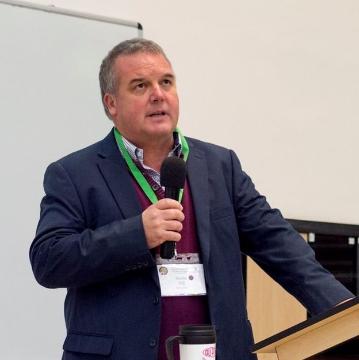SARChI Research Chair in Entomology
Distinguished Professor of Entomology
Director: Centre for Biological Control (CBC)
President of IOBC Global

Email: m.hill@ru.ac.za
Office: F18, First Floor, Life Science Building
Phone: 046 603 8712
PhD, Entomology, Rhodes University (1995)
Prof. Hill completed his PhD at Rhodes University in 1995. He worked at the Plant Protection Research Institute (PPRI) of the Agricultural Research Council in Pretoria from 1995 to 2002 and moved to Rhodes University as Head of Entomology from 2002. Promoted to full Professor in January 2009 and to Distinguished Professor in January 2018. Currently holds the South Africa Research Chair Initiative chair in “Insects in sustainable agricultural ecosystems”. In 2020, Martin was elected as the President of IOBC Gloabl.
Professor Hill’s research interests include the biological control of invasive alien aquatic weeds and insect pests. He has worked extensively throughout Africa on the control of aquatic weeds such as water hyacinth, salvinia, water lettuce, red water fern and parrot’s feather. Recent research includes the development of microbial agents (entomopathogenic fungi and viruses) for the control of pests in citrus and other crops.
Recent publicaitons
- van der Merwe, M., Jukes, M.D.; Knox, C.; Moore, S.D.; Hill, M.P. 2022. Mutualism between Gut-Borne Yeasts and Their Host, Thaumatotibia leucotreta, and Potential Usefulness in Pest Management. Insects 13: 243. https://doi.org/10.3390/ insects13030243
- Smith, R., Coetzee, J.A. and Hill, M.P. 2022. Best of both worlds: The thermal physiology of Hydrellia egeriae, a biological control agent for the submerged aquatic weed, Egeria densa in South Africa. BioControl 67:365–374. https://doi.org/10.1007/s10526-022-10142-w
- Motitsoe, S.N., Hill, J.M., Coetzee, J.A. and Hill, M.P. 2022. Invasive alien aquatic plant species management drives aquatic ecosystem community recovery: An exploration using stable isotope analysis Biological Control 173:
- Aigbedion-Atalor, P.O., Hill, M.P., Azrag, M.G.A., Zalucki, M.P. and Mohamed, S.A. 2022. Disentangling thermal effects using life cycle simulation modelling on the biology and demographic parameters of Dolichogenidea gelechiidivoris, a parasitoid of Tuta absoluta. Journal of Thermal Biology 107: 103260 doi: https://doi.org/10.1016/j.jtherbio.2022.103260.
- Zachariades, C., Uyi, O., Hill, M.P., Mersie, W. and Molo, R. 2022. The benefits to sub-Saharan Africa of the biological control of weeds: already considerable, but could be far greater. Current Opinion in Insect Science 52:100932 doi:https://doi.org/10.1016/j.cois.2022.100932
- Prinsloo, S., Hill, M.P., Moore, S.D., Malan, A.P. and Coombes, C.A. 2022. Interaction between an entomopathogenic fungus and entomopathogenic nematodes for improved mortality of Thaumatotibia leucotreta. Biocontrol Science and Technology 32 (10): 1194-1207, DOI: 10.1080/09583157.2022.2099528
- Coetzee, J.A., Miller, B.E., Paper, M., Cilliers, C.J. and Hill, M.P. 2022. Into Africa: Salvinia minima Baker (Salviniaceae) invades South Africa. Bioinvasion Records 11: (4): 1011–1018
- Coetzee, J.A., Miller, B.E., Kinsler, D., Sebola, K. and Hill, M.P. 2022. It’s a numbers game: Inundative biological control of water hyacinth (Pontederia crassipes) yields success at a high elevation, hypertrophic impoundment in South Africa. Biocontrol Science and Technology 32:11: 1302-1311, DOI: 10.1080/09583157.2022.2109594
- Chikowore,G., Martin, G.D., Chidawanyika, F., Hill, M.P., Neser, S., Day, M., Grice, T., Chikwenhere, G., Mangosho, E. and Sheppard, A. 2003. Weed biological control in Zimbabwe: Challenges and future prospects. South African Journal of Botany 154: 336-345.
- Mason, P.G., Mc Kay, F., Silvestri, L.C., Hill, M.P., Weyl, P., Hinz, H.L., Brodeur, J., Vitorino, M.D. and Barratt, I.P. 2023. International agreement for the use and exchange of classical biological control genetic resources: a practical proposal. BioControl68:329–339 https://doi.org/10.1007/s10526-023-10177-7
- Mason, P.G., Barratt, B.I.P., Mc Kay, F., Klapwijk, J.N., Silvestri, L.C., Hill, M.P., Hinz, H.L., Sheppard, A., Brodeur, J., Vitorino, M.D., Weyl, P. and Hoelmer, K.A. 2003. Impact of Access and Benefit Sharing implementation on biological control genetic resources. BioControl68:235–251 https://doi.org/10.1007/s10526-023-10176-8
- Ivey, P.J., Hill, M.P., Kenfack Voukeng, S.N. and Weaver, K. 2023. Nagoya Protocol and Africa’s willingness to share biological control agents, are we deterred by barriers instead of using opportunities to work together? BioControl 68:253–259 https://doi.org/10.1007/s10526-023-10184-8
- Mason, P.G., Hill, M.P., Smith, D., Silvestri, L.C., Weyl, P., Brodeur, J. and Vitorino, D.M. 2023. Best practices in the use and exchange of microorganism biological control genetic resources. BioControl 68:311–327 https://doi.org/10.1007/s10526-023-10197-3
- Cabrera Walsh, G., Sosa, A.J., Mc Kay, F., Maestro, M., Hill, M.P., Hinz, H., Paynter, Q., Pratt, P., Sathyamurthy, R., Shaw, R., Tipping, P. and Winston, R.L. 2023. Is biological control of weeds conservation’s blind spot? The Quarterly Review of Biology 98: 1-28.
- Buitenhuis, R., Cock, M.J.W., Colmenarez, Y.C., De Clercq, P., Edgington, S., Gadaleta, P., Gwynn, R., Heimpel, G., Hill, M., Hinz, H.L., Hoddle, M.S., Jäkel, T., Klapwijk, J.N., Leung, K., Mc Kay, F., Messelink, G.J., Silvestri, L., Smith, D., Sosa, A., Wäckers, F.L., Cabrera Walsh, G., Wyckhuys, K.A.G. & Zaviezo, T. 2023. Sustainable use and conservation of microbial and invertebrate biological control agents and microbial biostimulants. Background Study Paper No. 71. Commission on Genetic Resources for Food and Agriculture. Rome, FAO. https://doi.org/10.4060/cc3571en
- Nqayi, S.B., Zachariades, C., Coetzee, J.A., Hill, M.P., Chidawanyika, F., Uyi, O. and McConnachie, A.J. 2023. An assessment of cold and heat tolerance in the different life-stages of Dichrorampha odorata Brown and Zachariades (Lepidoptera: Tortricidae) and its implications on field performance in South Africa. African Entomology 31: e13597 (10 pages) https://doi.org/10.17159/2254-8854/2023/a13597
- Reid, M.K., Coetzee, J.A. and Hill, M.P. 2023. Love at first bite? Pre-release surveys reveal a novel association between a native weevil and the invasive Nymphaea mexicana Zuccarini (Nymphaeaceae) in South Africa. African Entomology 31: e14949 https://doi.org/10.17159/2254-8854/2023/a14949.
- Mushore, T., Coombes, C.A. and Hill, M.P. Entomopathogenic fungi associated with cultivated honeybush, Cyclopia spp., in South Africa and their pathogenicity towards a leafhopper pest, Molopopterus (Hemiptera: Cicadellidae. African Entomology 31: e14183 (7 pages) https://doi.org/10.17159/2254-8854/2023/a14183
- Reid, M.K., Paterson, I.D., Coetzee, J.A., Gettys, L.A. and Hill, M.P. 2023. Know thy enemy: Investigating genetic contributions from putative parents of invasive Nymphaea mexicana hybrids in South Africa as part of efforts to develop biological control. Biological Control 184:105291 https://doi.org/10.1016/j.biocontrol.2023.105291
Last Modified: Wed, 26 Jul 2023 10:12:28 SAST
